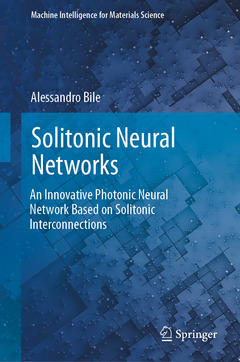Solitonic Neural Networks, 1st ed. 2024 An Innovative Photonic Neural Network Based on Solitonic Interconnections Machine Intelligence for Materials Science Series
Auteur : Bile Alessandro

This book delves into optics and photonic materials, describing the development of an intelligent all-optical system capable of replicating the functional building blocks of the biological brain. Starting with an analysis of biological neuronal dynamics and traversing the state of the art of neuromorphic systems developed to date, the book arrives at a description of neural networks realized through spatial soliton technology.
After a brief introduction to the biology of neural networks (Chapter 1), the book delves into the description of the neuromorphic problem emphasizing the peculiarities of optical hardware developed to date. (Chapter 2). Chapter 3 is dedicated to the description of psychomemories , which represent the modeling of human learning according to the theories of modern neuro-psychology. This chapter provides the prerequisites for understanding how solitonic neural networks (SNNs) are able to learn and how they approach biological models. Chapter 4 focuses on the experimentation of solitonic optic neurons in thin layers of lithium niobate. Optical techniques for supervised and unsupervised learning are discussed. The entire chapter is accompanied by theoretical, simulative and experimental results. This chapter explains how an X-junction neuron is able to establish synapses, modify them, or erase them. The erasure of solitonic structures represents an important innovation in the field of nonlinear optics. Finally, Chapter 5 reports on the implementation of a network of neurons capable of processing information and storing it exactly as a human episodic memory does. The chapter ends with a number of insights into the lines of research that are currently being pursued on the basis of the results obtained.
The book is meant for graduate students and researchers in the fields of optics, photonic applications, and biology. However, the main beneficiaries of this book are senior researchers in the field of nonlinear optics and artificial intelligence. To fully understand the results, it is important to have a basic knowledge of optical physics and neuron biology.
- The Neuron: the fundamental unit of nervous system
- Neural Networks and active synaptic interconnections
- Biological Memory
2. Pyschomemories
- Episodic Memory
- Representative memory
- Semantic Memory
3. The solitonic X-junction as a photonic neuron
- Photorefractive Solitons
- Supervised and Unsupervised Learning
- Photorefractive Solitons
- Mathematical model of the X-Junction
- Biological Synapsis vs optical solitonic interconnection
4. Experimental writing and erasing of photonic neurons in LNOI thin films
- The LNOI physics
- Implementation of the solitonic X-Junction neuron in LNOI
- Study of a smooth erasing process
5. Solitonic Neural Network acting as an episodic memory
Alessandro Bile graduated in Theoretical Physics (2017-2018) from Sapienza University of Rome, where he was involved in the VIRGO experiment. During his studies, he developed a passion for music and also graduated from the "Santa Cecilia" Conservatory (2017-2018) in Rome, combining gravitational wave physics and music in his thesis. He participated as a composer in concerts held in Rome and New York. In 2019, he furthered his education by attending a postgraduate training course on Machine Learning in Bergamo. At the Sapienza University of Rome, he completed his Ph.D. in Electromagnetism (obtaining the title of Doctor Europeaus) in 2022, focusing his research on photonic artificial intelligence. Currently, he is engaged in mathematical modeling and the design of intelligent hardware systems operating in the optical domain. Alessandro Bile has presented his research at international conferences across Europe and served as a research fellow from 2019 to 2023 at the Department of Basic and Applied Sciences for Engineering at Sapienza University. From 2019 to 2021 he contributed to the European project "Collection Care." In 2022, he continued his work with the same department on the project "Intelligent optical systems for the recognition and sanitation of pathological micro-organisms and nano-organisms". Additionally, he applies artificial intelligence techniques to the microclimate of cultural heritage to provide valuable predictions for the conservation of artistic artifacts. Alessandro Bile has received funding for young researchers for three consecutive years from 2020 to 2022. In 2022 he won the BGF funding from the French government to pursue his research as Visiting Research at the Femto-ST Institut University of Besançon (France). In the same year, he collaborated, as research fellow, with the University of Turin on the project "Biophysical forecasting modeling in the surface boundary
Presents an updated overview of hardware neuromorphic intelligence
Highlights technologies relevant in various areas of optics and photonic materials
Covers advancements in AI that are relevant to both academia and industry
Date de parution : 12-2023
Ouvrage de 105 p.
15.5x23.5 cm
Disponible chez l'éditeur (délai d'approvisionnement : 15 jours).
Prix indicatif 126,59 €
Ajouter au panier


